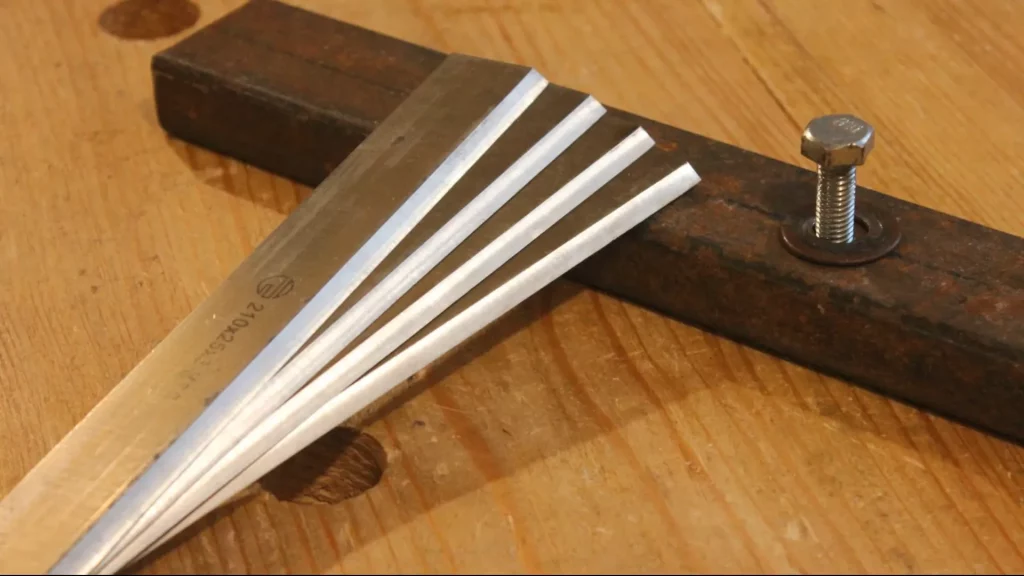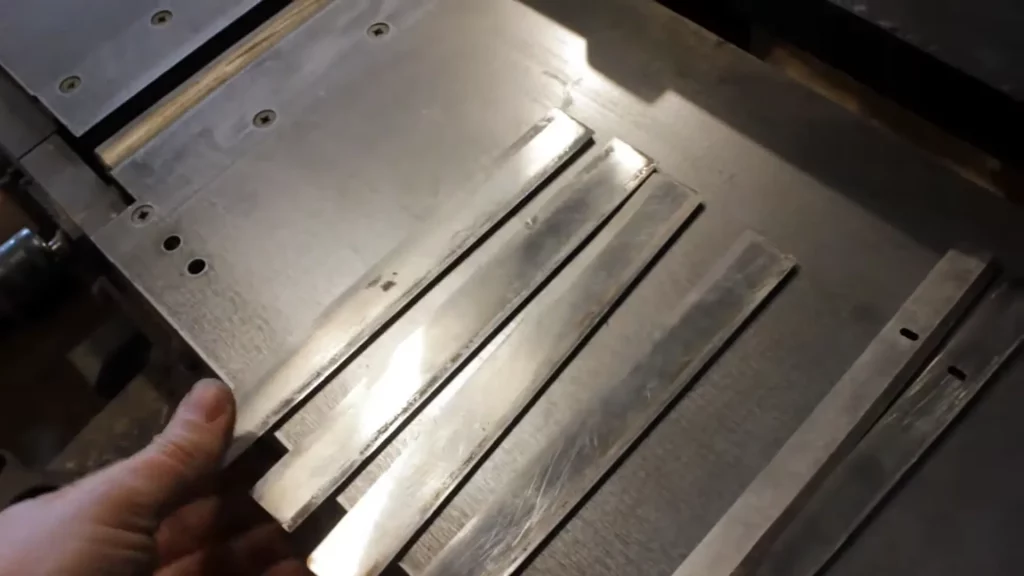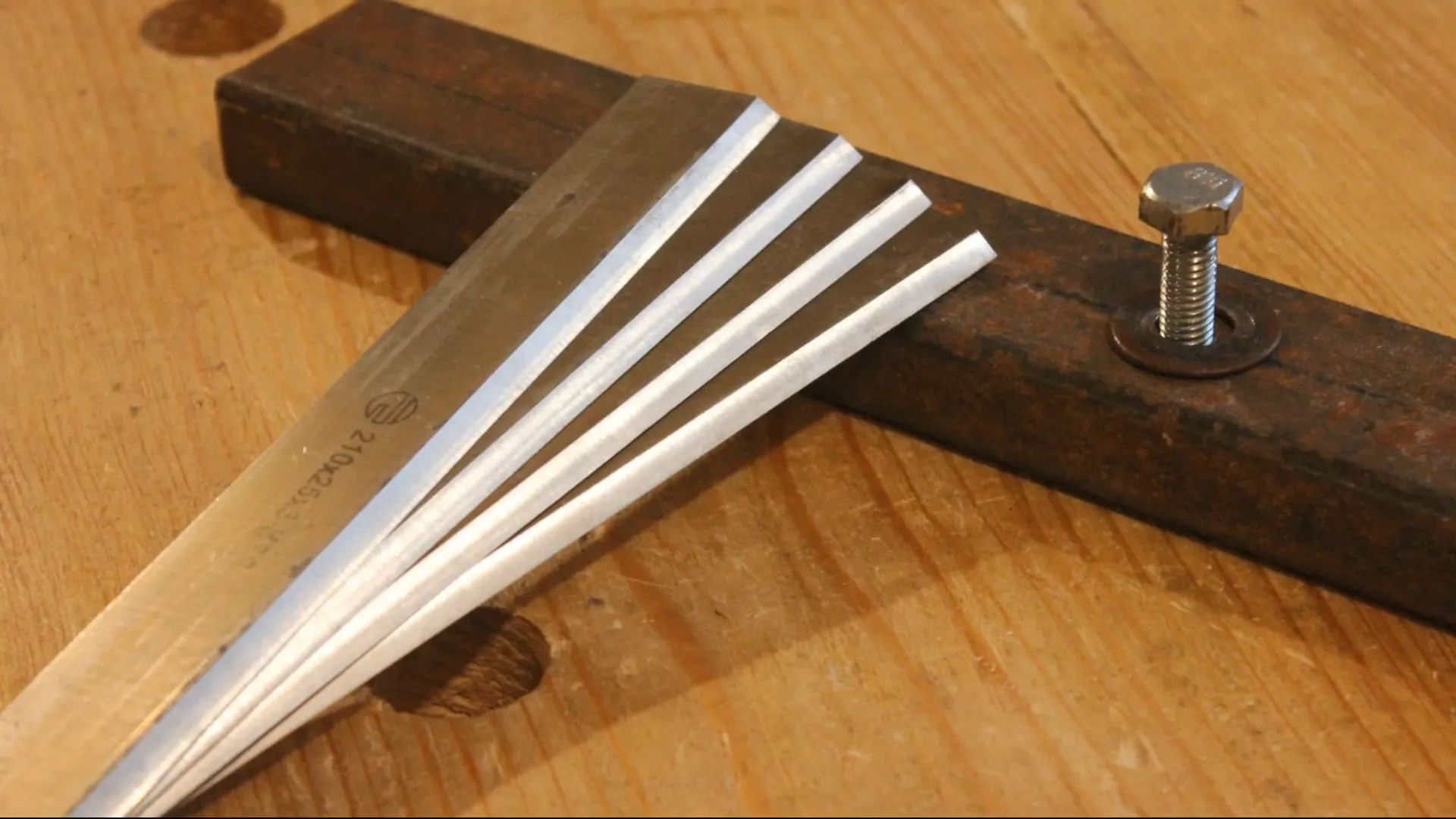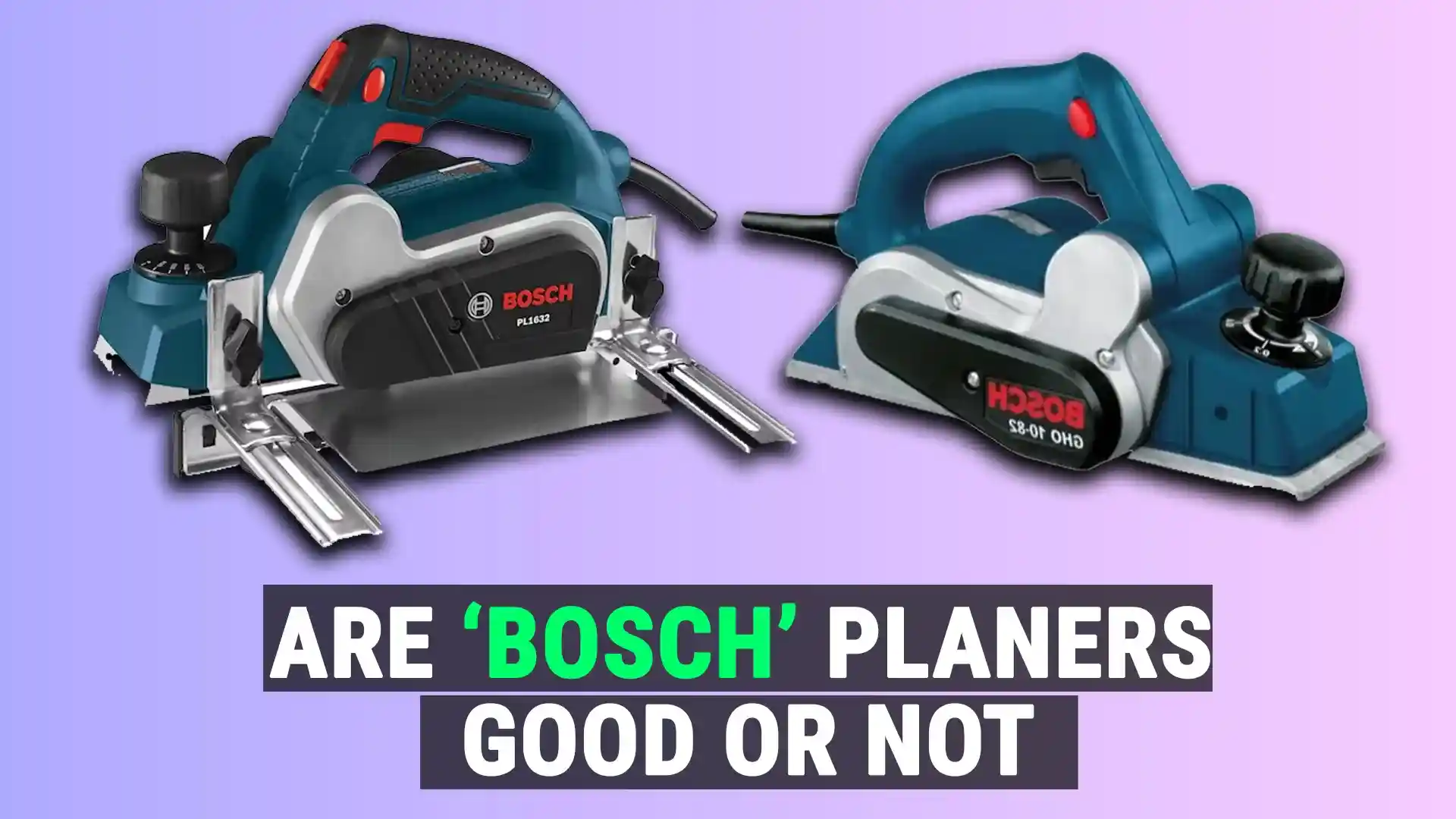How Long Do Planer Blades Last in 2025?
Planer blades typically last 1-2 years with frequent hobbyist use, with proper maintenance and blade replacement.
Carbide-tipped blades last 2-4 times longer than standard HSS steel, with carbide blades lasting 3-5 years for hobbyists.
Professionals may get 1-2 years from carbide blades with daily use. Proper care like sharpening, cleaning pitch buildup, and waxing blades extends lifespan.
In this in-depth guide, we’ll look at everything that impacts planer blade life so you can maximize the lifespan of your blades.

Blade Material
The material your planer blades are made from is one of the biggest factors determining blade life. Planer blades are typically made from either high speed steel (HSS) or carbide.
High Speed Steel (HSS)
HSS blades are the most common type of planer blade. They are durable while still being cost effective. With proper maintenance, HSS blades can last 1-2 years for a hobbyist woodworker who uses their planer frequently. The lifespan may be shorter or longer depending on use.
HSS blades can plane all common species of wood, including hardwoods like oak and softwoods like pine. They do require frequent sharpening and replacement when they become too dull. HSS does not hold an edge as long as carbide, but the blades are inexpensive to replace as needed.

Carbide Tipped
Carbide tipped blades generally last 2-4 times longer than traditional HSS blades. The carbide material is significantly harder and more wear resistant than HSS steel. The carbide tips are brazed onto the steel base of the blade.
With frequent use, carbide tipped planer blades can often last 3-5 years for a hobbyist woodworker. Professionals who use their planer all day long may get 1-2 years of life from carbide tipped blades. The carbide holds an edge exceptionally well compared to HSS.
The downside is that carbide blades are more expensive than HSS. However, you’ll need to replace them far less often. Carbide is ideal for woodworkers who use their planer frequently.
Blade Usage Frequency
How often you use your planer will affect how long the blades last. A hobbyist who planes wood only periodically can expect their blades to last years. A professional cabinet maker who uses their planer for hours every day will go through blades much quicker.
For a hobbyist who uses their planer for a few hours per week, planer blades can easily last:
- 1-2 years for HSS blades with occasional sharpening
- 3-5 years for carbide tipped blades with less frequent sharpening
With daily, heavy use, a professional can expect life spans around:
- 6 months to 1 year for HSS blades
- 1-2 years for carbide tipped blades
Proper blade maintenance becomes even more critical with frequent use. Sharpening or replacing dull blades regularly is key to maximizing lifespan. Carbide blades hold an edge significantly longer than HSS with heavy workloads.
Type of Material Being Planed
The species of wood that you are planning also impacts blade life. Hardwoods like oak, maple, and walnut will dull planer blades faster than softwoods like pine, cedar, and spruce.
Rich exotic woods with a lot of silica like teak or ipe can wear down blades even faster. Alternating between hard and softwood species helps blades last longer.
Here’s a rough guide for how long planer blades will last based on the type of wood:
- Softwoods: 1-3 years with HSS, 4-6 years with carbide
- Hardwoods: 6 months – 2 years with HSS, 2-4 years with carbide
- Exotic woods: 3-6 months with HSS, 1-2 years with carbide
Always inspect blades after running harder woods through to check for dulling or damage. Consider alternating in a new set of blades just for those tough exotic woods.
Blade Quality
Higher quality planer blades generally last longer than cheaper blades. With either HSS or carbide blades, look for blades manufactured from quality materials, precisely ground, and well balanced.
Brand name blades from companies like Infinity, Freud, and Forrest generally outlast bargain options, even at the same price point. A $50 set of good HSS blades can far outlast a $50 set of generic blades.
With carbide tipped blades, ensure the carbide is brazed on properly. Cheap carbide tips can snap off the steel base after minimal use. Paying a little more for blades from reputable companies is well worth it for the extended blade life.
Proper Blade Care & Maintenance
Taking good care of your planer blades and performing regular maintenance can maximize their lifespan significantly. Here are some key maintenance tips:
- Inspect blades before each use for dulling, nicks, or damage
- Rotate or flip blades to ensure even wear
- Sharpen blades regularly as needed to keep a razor edge
- Clean blades and planer bed frequently of pitch and resin
- Wax blades to prevent rusting
- Store blades properly when not in use
- Upgrade to carbide for reduced long term maintenance
Sharpening your blades regularly, or replacing dull HSS blades, is the best way to maximize lifespan. Letting blades become overly dull will wear them down much quicker.
Cutting Technique
Your cutting technique when using the planer can also impact blade life. Making too heavy of a cut or forcing the wood through the planer strains the blades.
Follow these technique tips:
- Take light passes of 1/16″ or less
- Allow blades to cut rather than forcing through wood
- Plane with the grain as much as possible
- Avoid knots, screws, and embedded material
- Check feed speed isn’t too fast
- Adjust cutting depth for hardwoods
Rushing the cut and forcing the wood increases friction and heat buildup. This prematurely dulls the blades. Proper use helps your blades last longer.
Summary of Planer Blade Lifespans
Here is a quick summary of approximate planer blade lifespans under different conditions:
| Blade Type | Light Hobbyist Use | Frequent Hobbyist Use | Daily Professional Use |
|---|---|---|---|
| HSS | 2-5 years | 1-2 years | 6 months – 1 year |
| Carbide | 5-10 years | 3-5 years | 1-2 years |
HSS blades need frequent sharpening or replacement, while carbide holds its edge much longer lasting 2-4X as long. For hobbyists, inspect and sharpen HSS blades regularly, and replace once dulling is too frequent for effective sharpening. Professionals should use carbide tipped blades for extended life with heavy workloads.
Following proper maintenance and cutting techniques allows you to maximize the lifespan of your planer blades. Investing in quality carbide blades upfront can save money in the long run for avid woodworkers.
Signs Your Planer Blades Need Replacement
Even with the best maintenance, planer blades eventually wear out and need to be replaced. Here are the top signs it’s time to install a fresh set of blades:
1. Visible Nicks or Damage
Inspect your blades regularly for any visible nicks, chips, or damage. This is common when inadvertently hitting screws, knots, or dirty spots in wood. Damaged blades leave visible marks on the wood surface.
2. Blade Dullness
Gradually dull blades require more effort to make cuts. You’ll hear the planer motor straining as it takes heavier passes to plane the wood. Dull blades also burn wood more easily.
3. Tear Out
Excessive tear out of wood fibers on the surface is a sign of dull blades. The wood splinters rather than making clean cuts. Tear out worsens over time as blades dull.
4. Reduced Cutting Depth
Worn out blades won’t allow you to take the same depth of cut as sharpened blades. You may need to reduce the maximum cutting depth to compensate for dull blades.
5. Cutting Motor Overheating
As blades wear out, the cutting motor works harder causing overheating. This motor burnout risk increases over time with dull blades.
Once you notice any of the above signs, it’s time to consider rotating your blades or replacing them entirely. Waiting too long increases the risk of damage to your workpieces or planer.
Cost of Planer Blade Replacement
So what’s the damage when it’s time for new planer knives? Here are some typical costs:
- Benchtop Planer Blades – $30-60 per set. Many portable planers use 2-3 reversible double-sided blades.
- Floor Model Straight Blades – $70-120 per set of 2-3 blades. 12” and 15” planers need large, sturdy blades.
- Helical Cutterhead – $250-500 for the entire cutterhead assembly. Individual cutters are not replaceable.
- Carbide Inserts – $15-30 per insert. Only replace the 1-2 damaged cutters.
- Sharpening – $5-15 per blade to have professionally sharpened. Do this every year or two.
- Labor – $50-150 if you pay someone to swap and install new blades. It’s about an hour’s work.
Buying 2-3 sets of blades upfront saves money over time and ensures you always have sharp ones ready to go. Treat blades as a consumable shop item like sandpaper or Sawstop cartridges.
How to Make Planer Blades Last Longer
Here are some of the best tips to extend the lifespan of your planer blades:
Upgrade to Carbide-Tipped Blades
Carbide blades last 2-4X longer than standard HSS blades. They hold an edge better with less sharpening needed. The extra cost upfront will pay off in reduced long term blade replacements.
Sharpen Blades Frequently
Regular sharpening helps blades hold an edge longer vs. allowing them to become overly dull. HSS in particular needs frequent sharpening.
Clean Pitch Buildup
Clean blades and planer bed to prevent wood pitch and sap buildup. This resin will rapidly dull blades.
Wax Blades
Applying paste wax helps protect blade edges from corrosion. Wax new blades and refresh regularly.
Take Light Cuts
Avoid aggressive cuts over 1/16″ depth. Shallow cuts extend blade life.
Alternate Blade Sets
Dedicate a separate set of blades just for very hard woods to maximize lifespan.
With a quality blade material, proper care, light cuts, and frequent sharpening, your planer blades can last for many years of continued use. Investing in the right blades and taking the time to maintain them pays off.
Planer Blade Rotation
Rotating planer blades helps distribute wear evenly and extends lifespan. There are a few options for rotating blades:
Flip Blades
With double-sided HSS blades, simply flip each blade over to use the opposite side. This immediately provides a fresh cutting edge.
Rearrange Left/Right Blades
Swap the outfeed and infeed blades to even out wear. The outfeed blade encounters more wear on many planers.
Rotate With Additional Sets
Use multiple matched sets of blades. Rotate to a fresh set once the current set shows wear.
Use Indexing Inserts
Some planers accept indexable carbide inserts. Rotate each insert to an unused edge.
Check your planer manual for the recommended rotation sequence. This varies by planer type. Mark blades to track rotations.
Sharpening Planer Blades
Sharpening planer blades regularly is the best way to maximize their lifespan. Here are some tips:
- HSS blades can be sharpened many times. Carbide only periodically.
- Use a jig to hold blades at proper angles.
- Work slowly with a fine grit diamond stone.
- Test cut soft scrap wood to confirm sharpness.
- Lap blades if needed for a smooth edge.
- Protect blade edges with wax after sharpening.
Always remove blades and sharpen individually out of the planer. Mark blades to track their rotation schedule.
Pay attention to manufacturer sharpening guidelines on angles and bevels. Improper sharpening can shorten blade life. Touch up each edge several times as needed rather than grinding away metal excessively.
Signs Planer Blades Need Sharpening
Here’s how to identify when your blades need a fresh edge:
- Wood burn marks
- Increased tear out
- Wavy texture or ridges
- Chatter while cutting
- Must take very light cuts
- Motor working harder
At the first signs of dullness, lightly sharpen blades. Don’t wait until problems become severe. Quick touch-ups extend lifespan.
Planer Blade Replacement Tips
With replaceable HSS blades, you’ll eventually need to swap in new blades once worn down. Follow these blade replacement best practices:
- Buy quality carbide or HSS blades from reputable brands
- Replace all blades at the same time
- Clean planer bed before installing
- Stagger new and worn blades
- Make test cuts in scrap wood
- Break in blades with a soft wood
- Check blade lock bolts are tight
- Wax and clean new blades
Replace blades in sets to maintain proper balance. Stagger slightly dull blades with sharpened blades to ease into a fresh edge.
New blades may require a short break-in period before they achieve optimal cutting. Make a few test cuts in pine before running expensive wood.
Avoiding Planer Snipe
Planer snipe is when the wood edges dip at the end of a board during planing. This can quickly dull, nick, or damage blades.
To maximize lifespan, avoid snipe with these tips:
- Support infeed and outfeed wood extension
- Adjust blade height just above the wood
- Take very light final passes
- Check for smooth bed movement
- Plane thinner boards
- Upgrade planer rollers
Snipe puts extra force on the blade edges. Properly supporting the wood, adjusting the height, and planing thin wood reduces snipe. Quality rollers also improve the cut.
Planing Difficult Materials
Planing woods with knots, bark pockets, dirt, rocks, and other contaminants will rapidly dull blades. Use caution when planning:
- Live edge slabs
- Reclaimed wood
- Pallet wood
- Trees and logs
Inspect these materials thoroughly and remove any debris. Run problem spots through a metal detector. Consider using a disposable set of blades just for these materials to preserve your good blades.
Should You Plane End Grain?
End grain planning rapidly dulls blades. The open wood cells act like miniature knives chiseling the steel.
- Avoid end grain planing when possible
- Ensure blade lock knobs are very tight
- Take extremely light passes
- Expect to replace blades more often
If you must plane end grain, minimize the amount. Plan it last after all other milling. Expect to swap blades frequently as they’ll dull quickly.
Impact of Planer Feed Rate
Adjusting planer feed speed, or feed rate, can also influence blade life. Too fast of a feed rate increases cutting friction and blade wear.
- Start at slower feed rates
- Increase speed gradually for best cut
- Reduce feed rate for difficult woods
- Watch for overload signs
- Consult your manual
Work at the optimum feed rate for your specific planer and current wood type. You want smooth feeding without too much resistance.
Blade Wear Over Time
Planer blades gradually wear down with use. Tracking blade life stages helps monitor when to sharpen or replace:
Stage 1: Brand New
- Sharp, smooth edge
- Minimal effort to plane
- No burning
Stage 2: Lightly Worn
- Still cuts well
- Might show slight wood burn
- Can sharpen to restore edge
Stage 3: Moderately Worn
- Noticeable burn marks
- Requires lighter passes
- Time to sharpen or replace
Stage 4: Severely Worn
- Significant wood burning
- Hard to make any cuts
- Blade facets clearly rounded over
- Needs replacement
Replacing blades at stage 3, before severe rounding, allows you to get the maximum lifetime from each blade.
Planing Highly Abrasive Woods
Some tropical and exotic hardwoods are extremely abrasive due to silica content. These will wear down planer blades much faster:
- Ipe
- Wenge
- Purpleheart
- Cumaru
- Teak
- Rosewoods
When possible:
- Use a weaker/disposable blade set
- Restrict board width to 6″ maximum
- Take very light passes
- Run slow feed rate
- Expect to change blades frequently
Alternate these woods with softer species to give your regular blades a rest. Consider having a dedicated set of lower quality blades just for these highly abrasive woods.
Preventing Rust on Planer Blades
Rust is the enemy of any steel tool. Here are some tips to prevent planer blade rusting:
- Wax blades regularly with paste wax
- Clean off any pitch after use
- Avoid getting blades wet
- Store blades with a light coat of oil
- Change to stainless steel or carbide blades
The humidity and sap in woodworking shops can corrode steel over time. Carefully wiping and oiling blades prevents deterioration.
Planing Wood With Bark Pockets
Wood milled from logs often contains pockets of bark trapped inside. This can quickly damage planer blades.
Options when planing these lumber types:
- Scan with a metal detector first
- Avoid planing over suspected bark pockets
- Hand plane problem areas instead
- Expect to replace blades more often
- Use a disposable/sacrificial blade set
Taking a very light final skim pass over bark sections may work. But it’s often safer to avoid or hand plane those areas.
The Impact of Knots on Planer Blades
Wood knots create a significant hazard to planer blades. The density variation and loose grain around knots can chip, tear, and fracture blades.
When knots are unavoidable:
- Carefully inspect boards and avoid knots
- Plane a sacrificial wood first to expose knots
- Set planer for a very light pass depth
- Expect some blade damage
- Touch up nicks immediately
Inspect each board thoroughly and feel for knots. Digging into a knot invariably nicks blades. Go slow and light over any visible knots.
Should You Use Reversible Planer Blades?
Reversible, or double-sided, blades let you flip and reuse once the first side becomes worn.
Potential benefits include:
- Immediately get a fresh edge
- Maximizes use of blade metal
- Low cost of entry
However, there are also downsides:
- Limited total number of flips before unusable
- Flipping can introduce inconsistencies
- No indexing inserts for gradual rotation
For hobbyists, reversible blades provide an economical way to get more life. But frequent flipping may introduce variation. Indexable carbide inserts allow more incremental rotations.
Signs of Dull Planer Blades
It’s important to recognize when your planer blades are becoming dull so you can sharpen or replace them. Here are the top signs of dulling blades:
- Increased tearout of wood fibers
- Burn or scorch marks on the wood
- Wavy or rough texture to the wood
- Need to take very light passes
- Chatter, vibration, or noise while cutting
- Planer motor working harder
At the first signs of dulling, take the time to sharpen your blades. Continuing to use overly dull blades will damage wood and wear the blades down faster.
Maximizing Planer Blade Life With Maintenance
Consistent maintenance makes a big difference in the lifespan of your planer blades. Here are key maintenance tips:
- Clean the blades after every use to remove pitch buildup using a solvent like denatured alcohol.
- Wax the blades periodically with paste wax to prevent rusting. Reapply frequently.
- Check blade tightness before each use. Snug down any loose gibs or adjustment bolts.
- Inspect for damage like nicks, chips or cracks before each use. Replace damaged blades.
- Sharpen frequently at the first sign of dullness to restore a keen edge.
- Rotate blades to even out wear by flipping reversible blades or swapping left/right blades.
- Store properly when not in use. Lightly oil blades and keep in a dry location.
Proper blade maintenance removes the friction, corrosion and damage that wears blades down prematurely. Invest 5 minutes after each use to clean and inspect.
Planing Woods With High Silica Content
Some exotic woods like ipe and teak contain extremely high silica content. This quickly wears down steel planer blades.
When milling these abrasive woods:
- Use your worn out blade set
- Restrict board width to reduce strain
- Take very light 1/64″ passes
- Expect to change blades frequently
- Consider using disposable blades
Alternate these woods with softer species to give your blades a rest. Never force these dense boards through the planer. Go slow with tiny cuts to make the difficult material easier on blades.
How Moisture Impacts Planer Blades
Wood moisture content affects how quickly planer blades will dull. Green, wet wood will rapidly wear down blades.
Ideally, let wood dry to these moisture levels:
- Hardwoods: 6-8% moisture content
- Softwoods: 10-12% moisture content
If planing wet wood is unavoidable:
- Take the lightest cuts possible
- Reduce feed rate/speed
- Expect rapid blade wear
- Dry blades and wax frequently to avoid rust
The excess moisture creates friction that dulls blades very quickly. Letting wood dry first will greatly extend your blade life.
Frequently Asked Questions
Should I rotate planer blades?
Rotating blades helps distribute wear evenly and prolong lifespan. But it’s generally not necessary with modern helical cutterheads. For straight blades, swap the outer and inner blades periodically.
How much does it cost to sharpen planer blades?
You can expect to pay $5-15 per blade for professional sharpening. It’s a good idea every 30-50 hours of runtime. Sharpening extends useful blade life much longer than just using until completely dull.
Can I sharpen planer blades myself?
It’s possible but challenging for amateurs. You need a grinding jig to hold an exact bevel angle. Most woodworkers opt to have blades professionally sharpened unless doing it very frequently themselves.
Should I clean planer blades after each use?
It’s smart to wipe blades down after each use to prevent buildup of pitch, sap, and dust. Use a soft wire brush or specialty cleaning sticks to gently clear away debris. Never scrape blades with hard tools.
How often should I wax my planer bed and blades?
Apply a light wax layer to the bed and blades every 5-10 hours of use. Paste wax prevents rust on blades and allows workpieces to glide smoothly through the planer.
How much planer usage is considered heavy?
If you’re using the planer for 1-3 hours daily, multiple times a week, that’s considered heavy use. Light hobby use would be planing for an hour or two once or twice per week. The blades last much less time with daily heavy work.
Should I spray my blades with lubricant?
Spray-on lubricants can help wood slide across the blades little easier. But they also attract more dust and debris. Waxing the planer bed is better than oiling the blades. The friction actually helps keep blades from overheating at high speeds.
Final Words
The lifespan of your planer blades comes down to the quality of the blades, how often you use them, the wood species, and most importantly – how well you maintain them.
With high quality carbide tipped blades, proper care, and frequent sharpening or replacement as needed, a hobbyist woodworker can achieve 3-5+ years of planer blade life. For professionals who plane heavily all day long, expect around 1-2 years even with carbide blades.
Monitor your blades for any signs of dullness, damage or wear. At the first indication, take the time to sharpen or swap in fresh blades. This will reward you with smooth cuts and maximum blade longevity.



